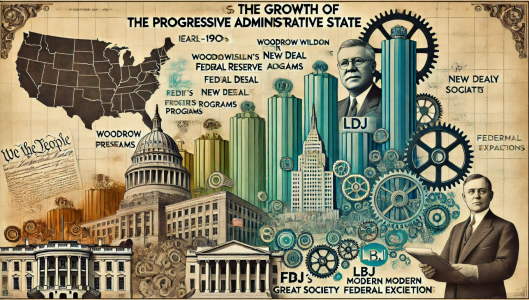Widgetized Section
Go to Admin » Appearance » Widgets » and move Gabfire Widget: Social into that MastheadOverlay zone
The Progressive Movement: From FDR to the Modern Administrative State
The views expressed are those of the author and do not necessarily reflect the views of ASPA as an organization.
By Charles Mason
February 7, 2025

The Progressive Movement in the early 20th century sought to reform American society through government intervention and establishing an administrative state. While its proponents argued that this was necessary to address the challenges of industrialization, inequality and economic crises, critics contend that it subverted the principles of the U.S. Constitution by expanding federal authority beyond its original limits. This article traces the growth of the federal government from Woodrow Wilson to Franklin D. Roosevelt (FDR). It examines how these developments laid the groundwork for the expansive administrative state in 2024.
Woodrow Wilson and the Foundation of Progressivism
Woodrow Wilson, a key figure in the Progressive Era, fundamentally challenged constitutional principles by advocating for a “living Constitution” that could adapt to society’s changing needs. He argued that the separation of powers, central to the Constitution, was outdated, stating, “Government is not a machine but a living thing. It falls not under the theory of the universe but under the theory of organic life.”
Key Milestones Under Wilson
The Federal Reserve Act of 1913 created the Federal Reserve System, centralizing monetary policy and diminishing Congressional control over currency.
The Revenue Act of 1913: Introduced a progressive income tax system following the ratification of the 16th Amendment.
The Federal Trade Commission (FTC) was established to regulate business practices, beginning significant federal economic involvement. By the end of Wilson’s presidency, federal expenditures had increased from $0.7 billion in 1913 to $18.5 billion in 1921, mainly due to World War I. However, his policies established a precedent for an expanded federal government role.
Franklin D. Roosevelt and the New Deal Revolution
FDR’s New Deal responded to the Great Depression but dramatically escalated federal power. His administration’s policies fundamentally altered the relationship between the federal government and the states, introducing a host of agencies and programs under the guise of economic recovery.
Key Milestones Under FDR: The National Industrial Recovery Act (NIRA) Created codes to regulate industries, which the Supreme Court later ruled unconstitutional in Schechter Poultry Corp. v. United States (1935).
The Social Security Act (1935) introduced the first federal social insurance program, establishing a precedent for entitlement programs.
The Agricultural Adjustment Act (AAA) controlled agricultural production, setting the stage for federal intervention in private enterprise. In 1937, FDR also sought to pack the Supreme Court, proposing to expand the number of justices to ensure support for his policies. Though unsuccessful, this effort demonstrated his willingness to bypass constitutional constraints.
Growth of Government Under FDR
Federal expenditures grew from $4.6 billion in 1933 to $9.6 billion in 1940, and federal employees rose from 605,000 in 1933 to over 1 million by 1940.
Post-War Growth: The Administrative State Expands. The administrative state continued to grow after World War II. President Lyndon B. Johnson’s “Great Society” programs in the 1960s, such as Medicare and Medicaid, further entrenched federal control over healthcare and welfare. By 1980, federal expenditures had reached $590 billion, up from $40 billion in 1940.
From the 20th Century to 2024: An Era of Unprecedented Growth
Key Statistics Reflecting Government Growth
Federal Budget: The federal budget was $9.6 billion in 1940; by 2024, it had exceeded $6.8 trillion. Federal Employees increased from 605,000 in 1933 to over 2.2 million in 2024 (excluding military personnel).
Federal Regulations: The Code of Federal Regulations grew from 18,000 pages in 1949 to over 185,000 pages by 2024, reflecting the increasing complexity of federal oversight.
The Modern Administrative State: Affordable Care Act (2010): Expanded federal control over healthcare, introducing a network of regulations and mandates.
Biden Administration (2021–2024): Focused on climate change and equity through executive orders and agency actions, bypassing Congressional authority.
The Constitutional Implications
The progressive expansion of the administrative state has increasingly bypassed the Constitution’s framework. The Founders envisioned a limited federal government with powers enumerated in Article I, Section 8. However, progressive policies have relied on broad interpretations of the Commerce Clause and the Necessary and Proper Clause to justify federal intervention in areas traditionally reserved for states. Critics argue that this shift has weakened the separation of powers, as unelected bureaucrats in federal agencies wield legislative, executive, and judicial powers. For example, The Environmental Protection Agency (EPA) enforces regulations that impact industries without direct Congressional approval. The Department of Education’s policies influence local schools despite education being a state responsibility.
Conclusion: A Call to Reassess
The progressive movement, beginning with Wilson and accelerating under FDR, fundamentally altered the balance of power between the federal government and the states. While these policies addressed significant economic and social challenges, they also laid the groundwork for the expansive administrative state of 2024. The Constitution’s principles of limited government, federalism and the separation of powers remain relevant, but they are increasingly at odds with the scope of modern governance. As federal spending, regulation and power grow, Americans must grapple with the implications for constitutional governance and individual liberty.
Author: Charles Mason, Ph.D., is a graduate of Walden University in Public Policy and Administration specializing in Criminal Justice. He is also a graduate of Barry University with an MPA and a graduate of Vincennes University with a Bachelor of Science in Homeland Security and Public Safety. He has over 30 years of experience in security, local law enforcement, state corrections and military service. He is currently president of Mason Academy. He can be reached at [email protected]. Twitter: https://twitter.com/DRCharlesMason


Follow Us!